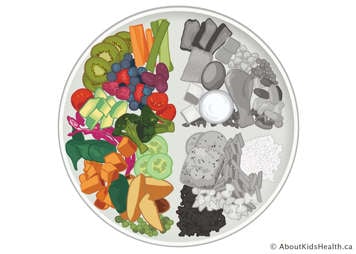Nutrients in vegetables and fruit
Vegetables and fruit are packed with nutrients that help support many of our body’s functions. We need them to maintain good health. Some examples are folate, vitamin A (beta carotene), vitamin C, potassium and fibre.
Folate is a B vitamin that the body needs for many functions including making healthy red blood cells. Some good sources of folate are cooked dried beans, peas and lentils, green leafy vegetables and oranges.
Vitamin A (beta carotene) and vitamin C help keep our eyes, skin, teeth and gums healthy. Carrots and sweet potatoes are good sources of beta carotene. Citrus fruit, cantaloupe and red peppers are good sources of vitamin C.
Vegetables and fruit are important sources of fibre. Fibre helps our digestive system work properly. There are many delicious foods that are good sources of fibre. Some examples are berries, pears, baked potato with the skin and green peas.
It’s important to eat a wide variety of colourful (green, yellow, orange, purple, red) vegetables and fruit. You may have heard the phrase ‘eat the rainbow’! Choosing a
variety of different coloured vegetables and fruit in your diet will ensure that you and your family get some of each important nutrient.
Canada’s Food Guide recommends that adults and older kids fill half their plate with vegetables and fruit, as part of a balanced meal.

How to help your family eat more vegetables and fruit
- Vegetables and fruits should be eaten every day. Aim to include vegetables and fruit with most meals and snacks.
- Start offering vegetables early in life (around 6 months of age), as babies can learn to enjoy even slightly bitter tastes when they are offered vegetables early and often.
- If you child does not like to eat fruit as a snack, try to offer it with a meal or after a meal. Orange slices or assorted fruits can be a fun dessert.
- There’s no need to get fancy. An easy way to give kids vegetables is to cut up raw carrots, red peppers, cucumbers, or broccoli. Keep these ‘grab ‘n go’ healthy snacks at kids’-eye-level in the fridge. Provide dips like creamy ranch dressing or hummus.
- Ways to cook vegetables: steam, roast, microwave, sauté or barbeque. Limit the addition of salt or sugar when cooking vegetables.
- Ask your child which texture of cooked vegetables they prefer. Some kids like them crunchy, some like them soft. Even if they do have a particular preference, try to expose your child to different textures and tastes by using a variety of cooking methods.
- Dried fruit is best to include as part of a meal, rather than as a snack. This can prevent them from being a factor in tooth decay (cavities). Try adding dried fruit to salads or hot/cold cereal.
- Frozen fruits, like blueberries, can be added to pancakes, yogurt or ice cream to increase your child’s daily nutrient intake.
True or false? Frozen fruits and vegetables are just as good as fresh.
For more videos from SickKids experts in collaboration with Youngster, visit Youngster on Youtube.
Final thoughts
As kids get older and become more independent, they will start making food choices for themselves. You can help foster their love for vegetables and fruits by being a good role model. Include lots of vegetables and fruit in your own meals and/or snacks, and let your children see you enjoying these healthy foods.